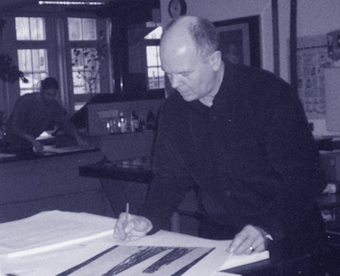 |
OHIO ARTIST PARTICIPATES IN INTERNATIONAL EXCHANGE

Nicholas Hill in the studio at the Dresden Graphic Workshop.
As part of an exchange between the Ohio Arts Council and the city of Dresden, Germany, Nicholas Hill was in residence at the Dresden Graphic Workshop from January 6 through February 15, 2003. The Dresden residency exchange is supported by the OAC's International and Individual Artist Programs.
Hill, of Granville, is professor and chairperson of the art department of Otterbein College in Westerville. He received his BFA at Michigan State University and his MA and MFA at the University of Iowa with an emphasis on drawing and a minor in painting and printmaking. His work has been shown in exhibitions throughout the United States and is featured in many published books.
The Dresden Graphic Workshop was founded in 1958 to preserve original printing techniques and encourage experimentation in printmaking. Artists and typographers work hand-in-hand at the facility to explore the possibilities of printmaking.
Of his time spent at the Dresden Graphic Workshop, Hill said, "The sense of support and sincere interest provided an important intangible that made me feel comfortable and ready to work."
As part of the exchange, the OAC will host two printmakers from Germany from September 27 through November 8, 2003. (Con't on page 2)
|
COMMUNITIES LEARN HISTORY THROUGH DRAMA
The Wallpaper Project and partner organizations throughout Ohio have developed an original play that will tour 40 communities between March and December 2003. The tour will visit every major city in Ohio, as well as a cross-section of small and medium-sized towns.
From Here: A Century of Voices from Ohio, is drawn from interviews of more than 800 residents across Ohio. The play was written by Cleveland playwright Eric Coble, who was recently named a "playwright to watch" by American Theatre Magazine.
The Wallpaper Project began in 1997. Oral histories were collected from 300 longtime and lifelong residents of Auglaize County to inspire an original dramatic production. Due to the positive response, project coordinators decided to expand statewide. So far, they have forged collaborations with 40 host sites for the latest production. Stories from each host community will be incorporated into the plays at each venue.
Like few other approaches, oral history has the capacity both to educate and empower the communities it reaches. Audiences realize that their neighbors, friends and relatives have told the (Con't on page 3)
|

![]()



